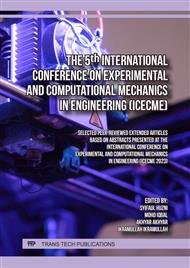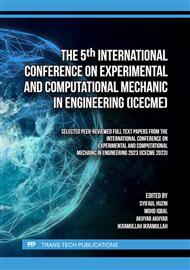[1]
Nowak B, Experimental study on the loosening of pedicle screws implanted to synthetic bone vertebra models and under non-pull-out mechanical loads Journal of the Mechanical Behaviour of Biomedical Materials 98 200-204 (2019).
DOI: 10.1016/j.jmbbm.2019.06.013
Google Scholar
[2]
E.C Benzel, Biomechanics of spine stabilization,3rd edition,American Society of Neurological Surgeon, Thieme, (2015).
Google Scholar
[3]
Qing-Bo Lv, Xiang Gao, Xiang-Xiang Pan, Hai-Ming Jin, Xiao-Ting Lou, Shu-Min Li, Ying-Zhao Yan, Cong-Cong Wu, Yan Lin, Wen-Fei Ni, Xiang-Yang Wang, Ai-Min WuA, 2018, Biomechanical properties of novel transpedicular transdiscal screw fixation with interbody arthrodesis technique in lumbar spine, finite element study Journal of Orthopaedic Translation, p.15, (2018).
DOI: 10.1016/j.jot.2018.08.005
Google Scholar
[4]
Ming Xu, James Yang, Isador Lieberman, Ram Haddas, Stress distribution in vertebral bone and pedicle screw and screw–bone load transfers among various fixation methods for lumbar spine surgical alignment: A finite element study, , Journal Medical Engineering and Physics 63,26–32, (2018)
DOI: 10.1016/j.medengphy.2018.10.003
Google Scholar
[5]
Abdulsalam A. Al-Tamim, Chris Peach, Paulo Rui Fernandes, Akos Cseke, PauloBartolo. Topology Optimization to reduce the stress shielding effect for orthopedic applications. Procedia CIRP 65 ; 202 – 206, (2017).
DOI: 10.1016/j.procir.2017.04.032
Google Scholar
[6]
Xiao-Xing Song, Lin-Yu Jin,Xin-Feng Li, Lie Qian, Hong-Xing Shen, Zu-De Liu, Bu-Wei Yu, Effects of Low Bone Mineral Status on Biomechanical Characteristics in Idiopathic Scoliotic Spinal Deformity: Word Neuro Surgery ; p :321- 329, (2018).
DOI: 10.1016/j.wneu.2017.10.177
Google Scholar
[7]
Weriono, Meifal Rusli, Roni Eka Sahputra, H.Dahlan, Finite element analysis of stress on thoracic and pedicle scre,w interface with various loading and bone quality, AIP Conference Proceedings; 2545, 020013, (2022).
DOI: 10.1063/5.0103465
Google Scholar
[8]
Torphong Bunmaprasert, Nattharut Chaibhuddanugul, Jakkrit Keeratiruangrong, Raphi Raphitphan, Nantawit Sugandhavesa, Wongthawat Liawrungrueang, Corrective osteotomy of global sagittal imbalance in the neglected fracture-dislocation thoracic spine, (2021)
DOI: 10.1016/j.tcr.2021.100409
Google Scholar
[9]
Weriono Weriono, Meifal Rusli, Roni Eka Sahputra, Hendery.Dahlan, Pedicle Screw Bond Strength and Resistance Characteristics With Various Mineral Quality, TEM Journal, Vol.13-1, 809-817, (2024).
DOI: 10.18421/tem131-83
Google Scholar
[10]
Marco Palanca *, Sara Oliviero , Enrico Dall'Ara. MicroFE models of porcine vertebrae with induced bone focal lesions: Validation of predicted displacements with digital volume correlation, journal of the mechanical behavior of biomedical materials, 125;104872, (2022).
DOI: 10.1016/j.jmbbm.2021.104872
Google Scholar
[11]
J. Clin, F.L. Naveaux, M.Driscoll, J.M. Thiong, H. Labelle, S. Parent, S. A. Shah, B S. Lonner, P.O. Newton, H. Serhan, Biomechanical Comparison of the Load-Sharing Capacity of High and Low Implant Density Constructs With Three Types of Pedicle Screws for the Instrumentation of Adolescent Idiopathic Scoliosis, Spine Deformity 7(1), 2-10 (2019).
DOI: 10.1016/j.jspd.2018.06.007
Google Scholar
[12]
Q.B. Lv, X. Gao, X.X. Pan, H.M Jin, X.T Lou, S.M Li, Y.Z Yan, C.C Wu, Y. Lin, W.F Ni, X.Y. Wang, A.M. Wu, Biomechanical properties of novel transpedicular transdiscal screw fixation with interbody arthrodesis technique in lumbar spine, finite element study, Journal of Orthopaedic Translation 15, 50-58, (2018).
DOI: 10.1016/j.jot.2018.08.005
Google Scholar
[13]
Z. Kamal, G. Rouhi, N. Arjmand, S. Adeeb, Stability-based model of a growing spine with adolescent idiopathic scoliosis: A combination of musculoskeletal and finite element approaches, Journal Medical Engineering and Physics 64, 46-55, (2019).
DOI: 10.1016/j.medengphy.2018.12.015
Google Scholar
[14]
Costa, M.C., Campello, L.B.B., Ryan, M., Rochester, J., Viceconti, M., Dall'Ara, E., Effect of size and location of simulated lytic lesions on the structural properties of human vertebral bodies, a micro-finite element study. Bone Reports 12, 100257, (2020).
DOI: 10.1016/j.bonr.2020.100257
Google Scholar



